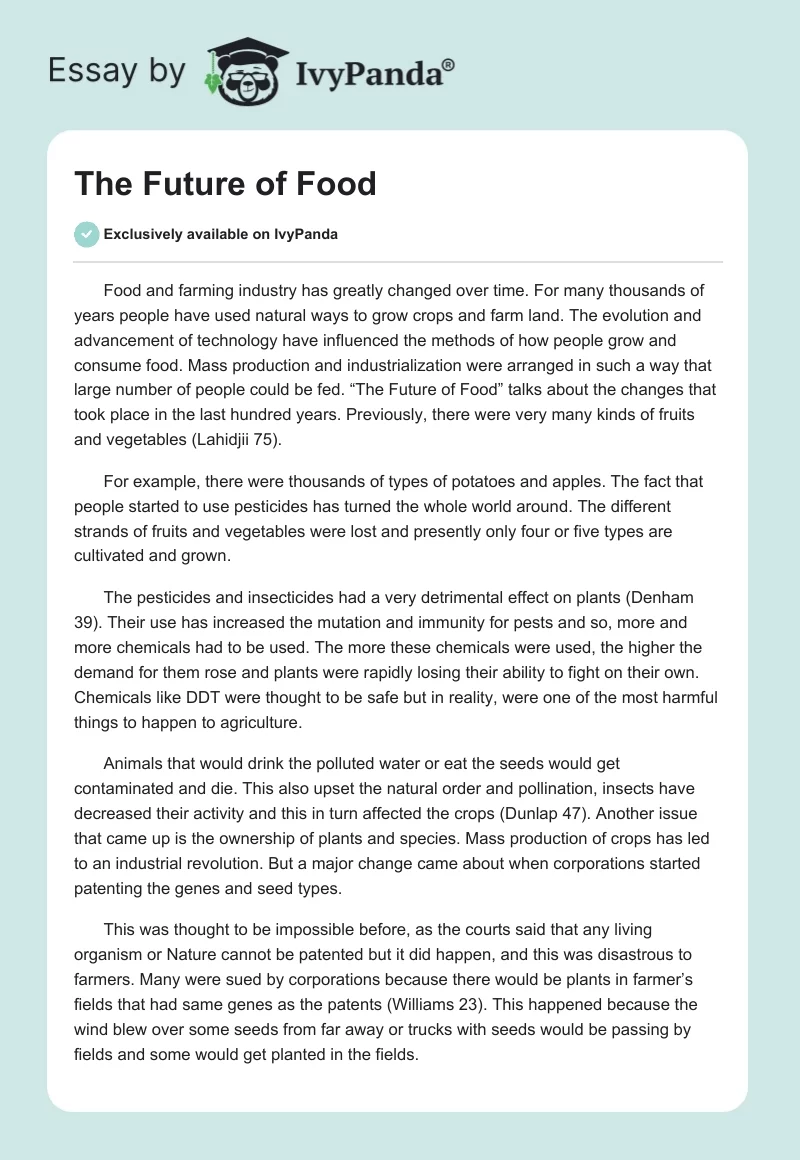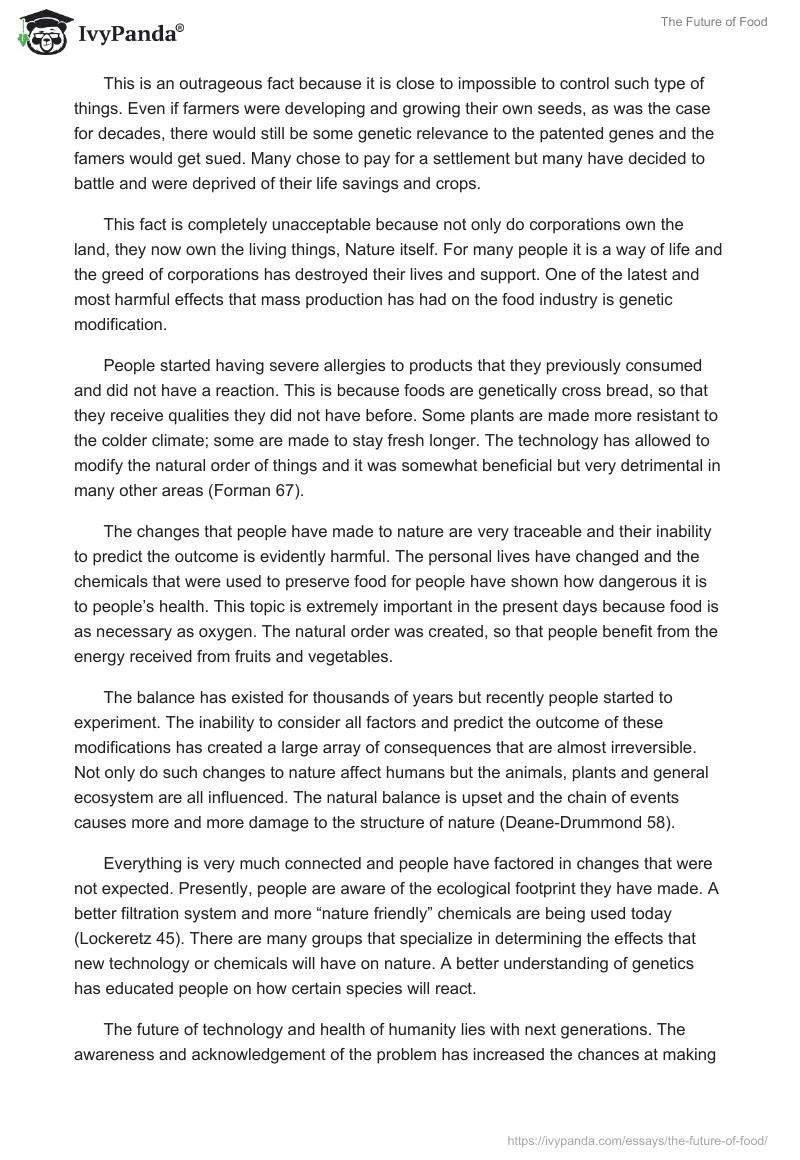Food and farming industry has greatly changed over time. For many thousands of years people have used natural ways to grow crops and farm land. The evolution and advancement of technology have influenced the methods of how people grow and consume food. Mass production and industrialization were arranged in such a way that large number of people could be fed. “The Future of Food” talks about the changes that took place in the last hundred years. Previously, there were very many kinds of fruits and vegetables (Lahidjii 75).
For example, there were thousands of types of potatoes and apples. The fact that people started to use pesticides has turned the whole world around. The different strands of fruits and vegetables were lost and presently only four or five types are cultivated and grown.
The pesticides and insecticides had a very detrimental effect on plants (Denham 39). Their use has increased the mutation and immunity for pests and so, more and more chemicals had to be used. The more these chemicals were used, the higher the demand for them rose and plants were rapidly losing their ability to fight on their own. Chemicals like DDT were thought to be safe but in reality, were one of the most harmful things to happen to agriculture.
Animals that would drink the polluted water or eat the seeds would get contaminated and die. This also upset the natural order and pollination, insects have decreased their activity and this in turn affected the crops (Dunlap 47). Another issue that came up is the ownership of plants and species. Mass production of crops has led to an industrial revolution. But a major change came about when corporations started patenting the genes and seed types.
This was thought to be impossible before, as the courts said that any living organism or Nature cannot be patented but it did happen, and this was disastrous to farmers. Many were sued by corporations because there would be plants in farmer’s fields that had same genes as the patents (Williams 23). This happened because the wind blew over some seeds from far away or trucks with seeds would be passing by fields and some would get planted in the fields.
This is an outrageous fact because it is close to impossible to control such type of things. Even if farmers were developing and growing their own seeds, as was the case for decades, there would still be some genetic relevance to the patented genes and the famers would get sued. Many chose to pay for a settlement but many have decided to battle and were deprived of their life savings and crops.
This fact is completely unacceptable because not only do corporations own the land, they now own the living things, Nature itself. For many people it is a way of life and the greed of corporations has destroyed their lives and support. One of the latest and most harmful effects that mass production has had on the food industry is genetic modification.
People started having severe allergies to products that they previously consumed and did not have a reaction. This is because foods are genetically cross bread, so that they receive qualities they did not have before. Some plants are made more resistant to the colder climate; some are made to stay fresh longer. The technology has allowed to modify the natural order of things and it was somewhat beneficial but very detrimental in many other areas (Forman 67).
The changes that people have made to nature are very traceable and their inability to predict the outcome is evidently harmful. The personal lives have changed and the chemicals that were used to preserve food for people have shown how dangerous it is to people’s health. This topic is extremely important in the present days because food is as necessary as oxygen. The natural order was created, so that people benefit from the energy received from fruits and vegetables.
The balance has existed for thousands of years but recently people started to experiment. The inability to consider all factors and predict the outcome of these modifications has created a large array of consequences that are almost irreversible. Not only do such changes to nature affect humans but the animals, plants and general ecosystem are all influenced. The natural balance is upset and the chain of events causes more and more damage to the structure of nature (Deane-Drummond 58).
Everything is very much connected and people have factored in changes that were not expected. Presently, people are aware of the ecological footprint they have made. A better filtration system and more “nature friendly” chemicals are being used today (Lockeretz 45). There are many groups that specialize in determining the effects that new technology or chemicals will have on nature. A better understanding of genetics has educated people on how certain species will react.
The future of technology and health of humanity lies with next generations. The awareness and acknowledgement of the problem has increased the chances at making a change for the better and every effort must be made to reverse the harmful consequences people have put in place.
Works Cited
Deane-Drummond, Celia. The Ethics of Nature. Malden, United States: John Wiley & Sons, 2008. Print.
Denham, Timothy. Rethinking Agriculture: Archaeological And Ethnoarchaeological Perspectives. Walnut Creek, United States: Left Coast Press, 2009. Print.
Dunlap, Thomas. DDT, Silent Spring, and the Rise of Environmentalism: Classic Texts. Seattle, United States: University of Washington Press, 2008. Print.
Forman, Lillian. Genetically Modified Foods EBook. Edina, United States: ABDO, 2010. Print.
Lahidjii, Reza. The Future of Food: Long-Term Prospects for the Agro-Food Sector. Danvers, United States: OECD Publishing, 1998. Print.
Lockeretz, William. Organic Farming: An International History. Cambridge, United States: CABI, 2007. Print.
Williams, Elizabeth. The A-Z Encyclopedia of Food Controversies and the Law. Santa Barbara, United States: ABC-CLIO, 2011. Print.


 3.80
3.80
